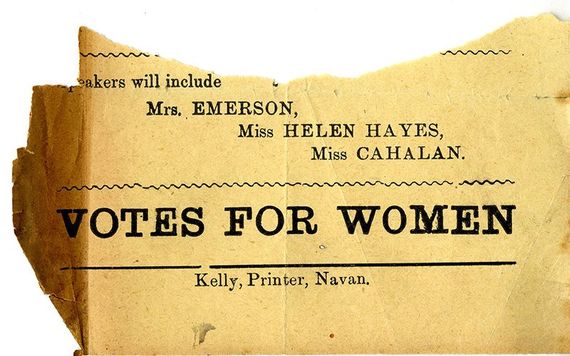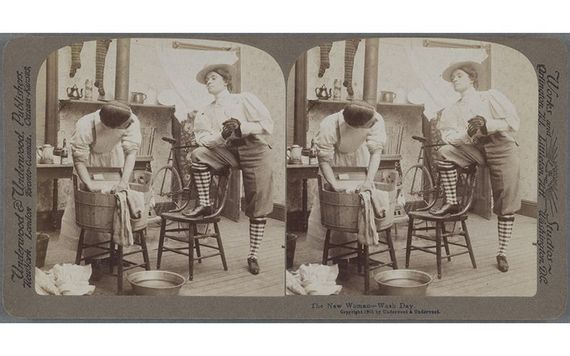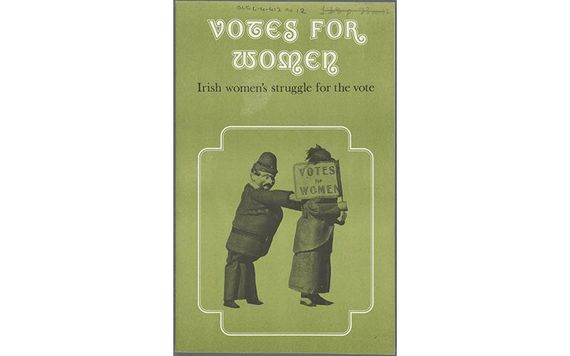Trinity College Dublin’s online exhibition plots Irish women’s road to the vote in 1918, how the campaign was an all-island activity and influenced by events in England.
“Violence, ridicule and silence: an inter-institutional exhibition plotting Irish women’s road to the vote in 1918” is a new collaborative online exhibition curated by the Library of Trinity College Dublin marking a hundred years of women’s suffrage in Ireland. It highlights how it was an all-island activity and very much influenced by events in England. It also demonstrates how violence and ridicule was used to prevent women from making their voices heard. The exhibition ends with the deep disappointment at the misogynistic 1937 Constitution which reneged on the equality ideals of the early activists.
Commenting on the exhibition, Trinity Library’s Principal Curator Dr Jane Maxwell says:
“The opponents of female suffrage were profoundly threatened by the possibility of its success. This is clear from the weapons with which they attacked it. Apart from the prevarication and lies of the constitutional politicians, women were everywhere mocked and shouted down when they spoke out and when that failed they were physically assaulted. The recent interest in the history of female suffrage in Ireland is welcome, however delayed it has been.”
The exhibition starts with the origins of social upheaval in the 18th century, with pioneering women in Ireland like Lady Arabella Denny (1707-1792) and Honora Sneyd Edgeworth (1751-1780) whose work in the areas of philanthropy and education paved the way for the constitutional suffragism of the 19th century. Other pioneers such as Anna Haslam (1829-1922), a founding member with her husband Thomas, of the Dublin Women’s Suffrage Association in 1876, cast her first vote at the age of almost 90 in 1918, surrounded by crowds of well-wishers.

Surviving fragments of a poster.
The exhibition goes beyond the apparent success of the Representation of the People Act in 1918 to the great disappointment of what happened next. Reneging on the promises of the 1916 Proclamation, the restrictions placed on the lives and rights of women by the Government in the 1920s and 30s read like a preface to Attwood’s The Handmaid’s Tale. The exhibition’s papers from the National Archives show de Valera being criticized by individuals and groups at home and abroad disappointed at the Constitution of 1937.
It also features well known figures such as authors Edith Somerville and Violet Martin who were members of the non-militant Munster Women’s Franchise League, (of which the militant Mary McSwiney was a co- founder), the revolutionary Anna O’Rahilly, the Gore Booth sisters, Eva and Constance Markievicz, as well as less well-known individuals.

Criticism of Eamon de Valera, in 1937.
Silence affects women's history, not alone in that their voices were not permitted to be heard but their records don't always make it to the archives and so their stories get lost.
An example is suffragist, Lillinian Metge (1880-1954) who remains a somewhat enigmatic figure, despite being, arguably, Ireland’s most militant suffragette. Metge bombed Lisburn Cathederal in 1914.
The exhibition also has particular relevance to Trinity College Dublin in terms of access to education. All through the 19thcentury the call for female access to education grew stronger, and it led many women to become more politicized. It features the first female honors graduates in 1906, including Ellen Frances McCutchan who graduated in Ethics and Logic as well as the earliest female medical graduates, sisters Madeline and Lily Stuart Baker (who went on to be the first woman to be conferred with an MD). Others include Brigid Stafford from Waterford, a suffragist who represented Ireland at the Conference of the International Women’s Suffrage Alliance in Paris, 1926. She was a civil servant in the Department of Industry and Commerce and a pioneer member of the Irish Federation of University Women.

Ridicule of a "manly" woman.
After half a century of ineffective constitutional activism, including petitioning government and holding public lectures, the 20thcentury suffragists decided that direct action was the only way to achieve success. Women fought a guerrilla campaign using every method available. From bombs and hunger strikes, to humor and heckling; they did whatever it took.
The reading of the Proclamation of the Irish Republic, outside the General Post Office by Padraig Pearse, marked the beginning of the Easter Rebellion 1916. Its guarantee of “religious and civil liberty, equal rights and equal opportunities to all its citizens” represented a strong pro-gender equality statement that reflected the ethos of the Volunteers and the involvement of many women in the armed struggle for Irish independence. These ideals were reneged on by the first Free State government.
The 1922 Free State Constitution enacted by the victorious pro-treaty side in the Civil War guaranteed the rights of women citizens in the Irish Free State. Women over 21 would have the right to vote and article three of the new constitution promised that the privileges and responsibilities of citizenship would be unaffected by gender. Optimism among suffrage campaigners was understandably high; they believed that their campaign had been successful and that the contribution of women in the cause of national independence was being recognized and repaid. This was far from being the case.

An illustration of a policeman and a suffragette figurine.
After 1923, women's rights to equal citizenship were deliberately and systematically undermined by restrictive anti-female legislation. 1926 Civil Service Act legalized a gender barrier in competitions for posts; the Juries Service Act 1927 effectively barred them from jury service; from 1932 female civil servants and teachers had to leave work on marriage; in 1934 there was a complete ban on the importation of contraceptives; in 1936 the Conditions of Employment Act empowered the minister to restrict the employment of women in industry; and the 1937 Constitution signified the home as the rightful place of women. Complaints flooded in.
In this centenary year the Library of Trinity College Dublin contributed to the work of the Houses of the Oireachtas Votáil 100 program in curating this exhibition which is in collaboration with sister institutions across the island of Ireland to draw attention to some of the lesser known aspects of the struggle. The collaborators include Queen’s University Belfast, University College Dublin, Public Record Office of Northern Ireland (PRONI), the Representative Church Body Library, the Hugh Lane Gallery, the National Archives, The National Museum, and the National Library.
To view the exhibition click here
Read more: Trinity digitally recreates seven centuries of Irish history lost in 1922 Four Courts fire




Comments